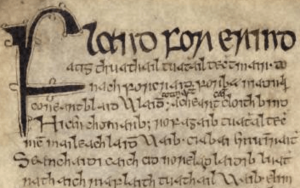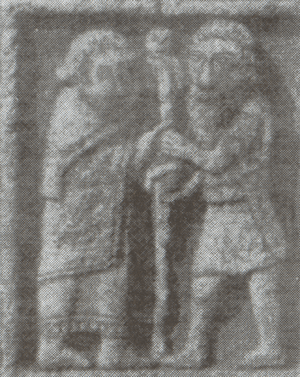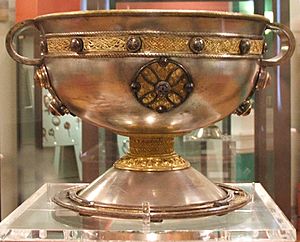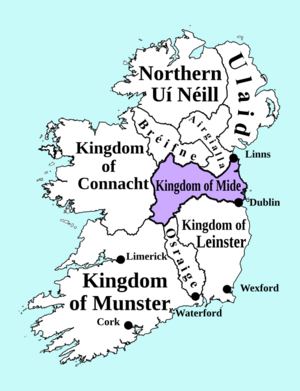Flann Sinna facts for kids
Quick facts for kids Flann Sinna |
|
|---|---|
| High King of Ireland | |

Opening lines of Máel Mura Othna's poem Flann for Érinn (Flann over Ireland), from the Great Book of Lecan (RIA MS 23 P 2), 296v
|
|
| Reign | 879–916 |
| Predecessor | Áed Findliath |
| Successor | Niall Glúndub |
| Born | 847 |
| Died | 25 May 916 (aged 68–69) Lough Ennel, Kingdom of Meath |
| Spouse |
|
| Issue |
|
| Father | Máel Sechnaill mac Máele Ruanaid |
| Mother | Land ingen Dúngaile |
Flann Sinna (born in 847, died 25 May 916) was a very powerful king in Ireland a long, long time ago. His full name was Flann mac Máel Sechnaill, but he was also known as "Flann of the Shannon." He was the High King of Ireland, which meant he was the most important ruler in the land. His father, Máel Sechnaill mac Máele Ruanaid, was also a famous king.
Flann became High King after his cousin and stepfather, Áed Findliath, died in 879. Like other High Kings, he started by getting promises and payments from other kingdoms, like Leinster. He also fought wars with other parts of Ireland, such as Munster, Ulster, and Connacht. Flann was very successful as a king. What made him special was how he used big stone crosses, called high crosses, to show everyone that he and his father were the true kings of Ireland. These crosses were like ancient billboards!
Flann might have wanted his own family to keep the kingship of Tara forever. This was different from the usual way, where kings from the north and south of the Uí Néill family took turns ruling. However, his plans were stopped when his favorite son, Óengus, was killed in 915. After this, some of Flann's other sons rebelled, and his power started to weaken.
Contents
Ireland During the Viking Age
The Viking Age in Ireland started in 795. This was when Vikings first attacked monasteries on islands like Rathlin. For the next 20 years, Viking raids were small and mostly happened along the coasts. The Annals of Ulster, which are like old Irish history books, only record raids in Ireland in five of the first 20 years of the 9th century.
In the 820s, the raids became bigger, especially in Ulster and Leinster. By the 830s, attacks were more frequent and covered more areas. In 837, Viking ships were sailing on important rivers like the Boyne and Liffey. By 839, a Viking fleet was even based on Lough Neagh in the north.
The first permanent Viking settlements were set up in 841 near Dublin and Annagassan. More fortified places were built later in Wexford, Waterford, Limerick, and Cork. This is when we start to hear the names of Viking leaders in Ireland. One famous leader was Turgesius, who was captured and drowned by Flann's father, Máel Sechnaill, in 845.
In 849, a new group of Vikings, called the "Dark Foreigners" (possibly from Denmark), arrived. They fought against the Vikings already in Ireland. In 853, another group, the "Fair Foreigners," arrived. They were led by Amlaíb Conung and Ímar. From the 840s onwards, Irish kings often made alliances with these "Foreigners," especially with Amlaíb and Ímar, who ruled Dublin.
By the late 860s, Viking activity slowed down. The Vikings from Dublin were busy fighting in Scotland and attacking Dumbarton Rock. Áed Findliath, who was Flann's stepfather, used this chance to destroy Viking forts in northern Ireland. Amlaíb left Ireland in 871, and Ímar died in 873. After they were gone, there was a lot of fighting among the Viking leaders themselves.
Flann's Father: Máel Sechnaill

The idea of a "King of Ireland" might have grown stronger because of two things: the threat from Feidlimid mac Crimthainn, the King of Munster, and the Viking raids.
Feidlimid's army from Munster traveled all over Ireland, even as far north as Inishowen. He had the support of the church in Cashel and his own strong army. Some sources say Feidlimid even made himself King of Tara. Although he was defeated in 841, his achievements were amazing. For a long time, only kings from the Uí Néill family were considered King of Tara.
When Niall Caille, the High King, died in 846, the kingship of Tara went to Flann Sinna's father, Máel Sechnaill. Feidlimid died the next year. Máel Sechnaill then worked to make his power bigger through wars and clever deals. What's interesting is how people talked about Máel Sechnaill's actions. The Annals of Ulster didn't call his armies "men of Mide" but "men of Ireland." This shows a new idea of a united Ireland.
When Máel Sechnaill died in 862, his obituary called him "King of all Ireland."
Áed Findliath: Flann's Stepfather
After Máel Sechnaill died, the Uí Néill kingship went back to the northern branch, led by Áed Findliath, Niall Caille's son. Áed started his rule by marrying Máel Sechnaill's widow, Land, who was Flann's mother.
Áed had some good wins against the Vikings. However, not everyone in the southern Uí Néill family accepted him as king. The historical records show that the important Fair of Tailtiu was not held six times during his reign. This was a sign that his power was not fully accepted. When Áed died in 879, the kingship returned to the southern branch, and Flann Sinna became king.
Flann first appears in historical records during his stepfather's rule. In 877, the Annals of Ulster say that Flann killed Donnchad, who was the King of Mide and head of the southern Uí Néill. Donnchad was Flann's second cousin. Flann might have married Áed Findliath's daughter, Eithne, around this time.
Flann's Reign: King Over Ireland
| 847 or 848: Flann Sinna is born |
| 862: Máel Sechnaill dies |
| 877: Flann kills Donnchad mac Eochocain, becomes King of Mide |
| 879: Áed Findliath dies |
| 882: Flann attacks Armagh |
| 888: Flann is defeated by the Foreigners at the Battle of the Pilgrim |
| 889: Domnall son of Áed Findliath raids Mide |
| 892: Many Foreigners leave Dublin |
| c. 900: Cathal mac Conchobair, King of Connacht, accepts Flann's authority |
| 901: Flann's son Máel Ruanaid is killed |
| 902: Foreigners leave, or are driven out, of Dublin |
| 904: Flann and his son Donnchad quarrel |
| 905: Flann attacks Osraige |
| 906: Flann raids Munster, the Munstermen attack back |
| 908: Flann and his allies defeat the Munstermen and kill their king, Cormac mac Cuilennáin |
| 909: Oratory at Clonmacnoise rebuilt in stone on Flann's orders |
| 910: Flann attacks the kingdom of Bréifne |
| 913 and 914: Flann and his son Donnchad raid south Brega, burning many churches |
| 914: Battle between Niall Glúndub and Óengus, son of Flann; Óengus is badly wounded |
| 915: Flann's sons Donnchad and Conchobar rebel; Flann names Niall Glúndub as his heir |
| 916: Flann dies |
Flann's rule started with him demanding promises from the kings of Leinster. In 882, he led an army of Irish and "Foreigners" (Vikings) into the north, attacking Armagh. Unlike later stories that made the Irish and Vikings bitter enemies, Irish kings often teamed up with Vikings when it helped them. It's possible one of Flann's sisters married a Viking leader.
In 887, the Annals of Ulster say that Flann was defeated by the "Foreigners" at the Battle of the Pilgrim. Important people, including a bishop and an abbot, died on Flann's side. That year, the Fair of Tailtiu was not held, which showed that Flann's power was not completely secure. However, the Vikings also had problems among their leaders. The Annals mention that a Viking king was killed by his own relative that same year.
In 892, things happening in England might have helped the Irish take back Dublin. The Annals report that after the Vikings were defeated by the Saxons (King Alfred the Great), there was "great disagreement" among the "Foreigners" in Dublin, and they split up. In 901, the Annals say that the "heathens" (Vikings) were driven out of Ireland by the men of Leinster and Brega.
In 901, Flann's son Máel Ruanaid, who was expected to be the next king of Ireland, was killed. In 904, Flann even broke into the Abbey of Kells to capture his son Donnchad, who had hidden there. Flann had been king for 25 years by this point.
In 905, Flann fought against his cousin Cellach, the King of Osraige. The next year, 906, Flann raided into Munster, causing a lot of damage. In return, the King of Munster, Cormac mac Cuilennáin, raided Connaught and Leinster. Some old records say Cormac even defeated Flann in a battle.
Prophecy and Final Years
| 49: He will take the lordship of Tara, pleasant it will be which will be over the plain of Brega, without plunder, without conflict, without battle, without swift slaughter, without death reproach. |
| 50: Twenty-five years, truly, will be the time of the high king; Tara of pleasant Brega will be full, there will be honour over every church. |
| 51: Neither spear nor sword will kill him, he will not fall by weapon-points in his going, in Lough Ennel he will die, after him it will be a noble fame. |
| The Prophecy of Berchán, an 11th-century verse history of Scots and Irish kings. |
On 13 September 908, Flann, with help from his son-in-law Cerball and the King of Connacht, fought against the Munstermen. Many of the Munstermen didn't want to fight because their leader, Flaithbertach, had fallen from his horse, which they saw as a bad sign. Flann and his allies won the battle. King Cormac of Munster was killed.
In 910, Flann defeated the men of Bréifne. In 913 and 914, first Flann's son Donnchad, and then Flann himself, raided lands in south Brega and southern Connaught. The Annals of Ulster say that "many churches were profaned" during Flann's campaign in 914. In December 914, a battle happened between Niall Glúndub and Óengus, Flann's son. Óengus died from his wounds in February 915. He was the second of Flann's chosen heirs to die before him.
Later in 915, Flann's sons Donnchad and Conchobar rebelled against him. Only with the help of Niall Glúndub were Flann's sons forced to obey. Niall Glúndub might have been named Flann's heir around this time. Flann died soon after, on 25 May 916, near Mullingar, after ruling for over 36 years.
After Flann's death, his son Conchobar became the head of his family and King of Mide. Niall Glúndub became the High King of Tara.
Flann's Family Life

Flann Sinna was married to at least three different women and had seven sons and three daughters that we know of.
His first marriage was probably to Gormlaith ingen Flann mac Conaing, the daughter of the King of Brega. Their children included Donnchad Donn, who later became King of Mide and High King, and a daughter also named Gormlaith.
Flann's daughter Gormflaith ingen Flann Sinna became famous in later stories, often shown as a sad figure. She first married Cormac mac Cuilennáin, who was a bishop and had promised to live a celibate life. After Cormac died in battle against her father in 908, she married Cerball mac Muirecáin, who was a key ally of Flann. Stories say Cerball treated her badly. After Cerball died in 909, Gormflaith married her stepbrother, Niall Glúndub, who died in 919. Some stories say she wandered Ireland begging after Niall's death, but this is likely a made-up tale.
Flann's second known marriage was to Eithne, daughter of Áed Findliath, around 877. Their son, Máel Ruanaid, was killed in 901. Eithne also married another king, but it's not clear if this was before or after Flann. Flann likely divorced Eithne to marry his predecessor's widow, which was a tradition. Eithne became a nun and died in 917.
His third wife, Máel Muire ingen Cináeda, died in 913. She was the daughter of the King of the Picts. She was the mother of Flann's son Domnall and his daughter Lígach.
The mothers of Flann's other sons—Óengus (died 915), Conchobar (died in battle), Áed (blinded by his half-brother), and Cerball—are not known. The mother of his daughter Muirgel (died 928) is also unknown. Muirgel was probably married to a Viking king.
Flann's Legacy
The way kings took turns ruling in Ireland, with the northern and southern Uí Néill families sharing the kingship of Tara, started to change around Flann's time. Some families had already been left out of the succession.
When Flann's son Máel Ruanaid was killed in 901, the Annals of Ulster called him "heir designate of Ireland." This suggests that Flann might have wanted to keep the kingship in his own family, instead of letting the northern Uí Néill family take their turn. However, his sons didn't always get along. Donnchad Donn rebelled against his father twice, which might have stopped these plans. Still, Óengus was also called "heir designate of Tara" when he died in 915.
Some historians believe that Flann tried to create a national kingship in Ireland, similar to what kings like Alfred the Great were doing in England at the same time.
Later kings from Flann's family, like his son Donnchad Donn, his grandson Congalach Cnogba, and his great-grandson Máel Sechnaill mac Domnaill, all became High Kings of Tara. Máel Sechnaill was the last of the traditional Uí Néill High Kings.
Flann's Image and Monuments
Flann had a special poet named Máel Mura Othna, who died in 887. In 885, Máel Mura wrote a poem called Flann for Érinn (Flann over Ireland). This poem connected Flann to the great deeds of an ancient Uí Néill ancestor, Túathal Techtmar. The poem showed Flann as a powerful ruler who could demand obedience from other kings and lead the "men of Ireland" in war. This was a new way of thinking about the High King's power.
A clear sign of Flann's power and claims can be seen in the tall stone crosses, called high crosses, that he ordered to be built at Clonmacnoise and Kinnitty. These crosses proudly name him and his father as rí Érenn, which means "King of Ireland." At the same time, the small church (oratory) at Clonmacnoise was rebuilt in stone because Flann ordered it.
Flann is also believed to have ordered the creation of the earliest known cumdach, which is a decorated case for a holy book, for the Book of Durrow.
See also
 In Spanish: Flann Sinna para niños
In Spanish: Flann Sinna para niños


